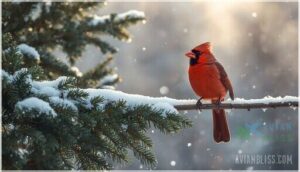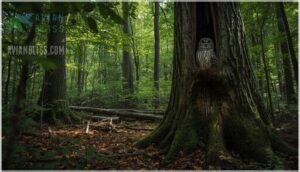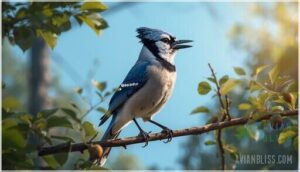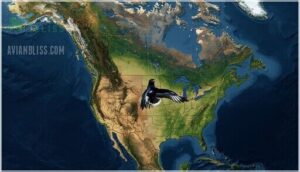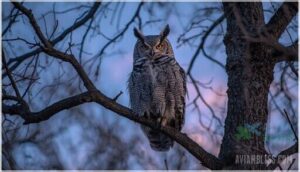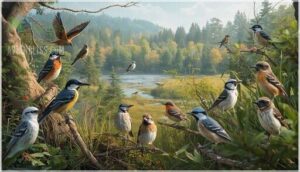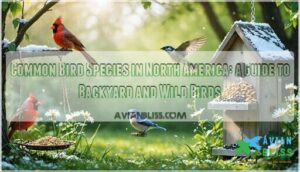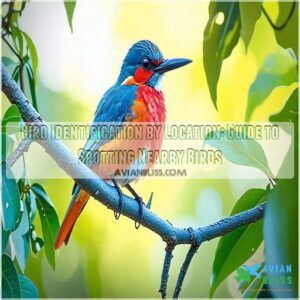This site is supported by our readers. We may earn a commission, at no cost to you, if you purchase through links.
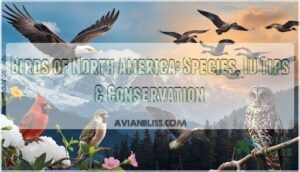
Whether you’re trying to identify that mysterious singer in your neighborhood or understand why certain birds appear only during specific seasons, knowing what to look for makes all the difference.
This guide breaks down common species, identification techniques, migration patterns, and conservation challenges facing birds across the continent, giving you the tools to recognize and appreciate the diverse avian life around you.
Table Of Contents
- Key Takeaways
- North American Bird Species
- Bird Distribution Patterns
- Bird Identification Methods
- Bird Conservation Status
- Frequently Asked Questions (FAQs)
- Which bird is only found in North America?
- What is the most common bird in North America?
- What are the 3 largest birds in North America?
- What is the rarest bird in the United States?
- What is unique about migratory bird behavior?
- How do birds adapt to urban environments?
- What are the vocalization patterns of songbirds?
- How do weather changes impact bird migration?
- What are common feeding habits of backyard birds?
- What do North American birds eat seasonally?
- Conclusion
Key Takeaways
- North America has lost nearly 3 billion breeding birds since 1970—a 29% decline driven by habitat loss, climate change, and human-related threats, with grassland species hit hardest at over 50% population loss.
- Bird identification relies on visual cues like plumage patterns, color patches, and distinctive field marks, enhanced by modern tools like smartphone apps that achieve 74-89% accuracy through AI-powered image recognition.
- Migration patterns across North America’s four major flyways are shifting northward at roughly 1.5 km per year due to warming temperatures, forcing species to adapt routes and timing while urban areas fragment habitats and reduce diversity.
- Conservation efforts through wetland restoration, habitat preservation, and federal funding programs have protected over 31 million acres since 1991, yet 42 “red-alert” species still face imminent extinction without swift intervention.
North American Bird Species
North America is home to hundreds of bird species, each with unique traits that help you identify them in the wild. From backyard visitors to forest dwellers, these birds showcase the continent’s rich biodiversity.
Let’s look at five species you’re likely to encounter and what makes each one stand out.
Northern Cardinal Description
The Northern Cardinal stands out among bird species descriptions with its unmistakable appearance. Males flash vivid red plumage and a distinctive black face mask, while females wear subtler fawn tones with reddish highlights—a striking example of plumage variation. You’ll spot their cone-shaped bill perfectly designed for cracking seeds, a key part of their cardinal diet.
These members of the Cardinals Grosbeaks and Buntings family stay put year-round, defending territories through distinctive vocalizations like “cheer, cheer.” During mating rituals, males even feed females beak-to-beak. The female cardinal usually incubates clutches of 3-4 eggs.
This territorial behavior and their love for backyard feeders make them easy to identify in any bird identification guide.
Barred Owl Habitat
You’ll find Barred Owls in mature forests across eastern North America, where dense canopies and old-growth trees provide ideal habitat. These North American birds depend on specific forest features for survival:
- Nesting cavities in large trees, usually 6–12 meters high
- Forest canopy coverage exceeding 60% for roosting
- Climate preferences favoring humid, temperate woodland zones
- Habitat adaptability allowing survival in secondary forests
Despite their flexibility, conservation threats like habitat loss and competition with spotted owls require ongoing protection efforts to preserve these iconic owls. They’re vulnerable to habitat loss due to human activities.
Blue Jay Identification
You can identify a Blue Jay quickly if you know its key features. Look for striking Plumage Variation—vivid blue wings, back, and crest paired with white underparts and a bold black collar forming a U-shape around the neck. That Crest Display changes with mood: raised when excited, flattened when calm.
Males and females look nearly identical, though Regional Differences exist—northern birds weigh more than southern ones. Juvenile Markings appear duller from May through August.
Listen for their Vocal Mimicry too, as these North American birds expertly mimic hawk calls alongside their signature “jay-jay” sound, making Identification of North American birds easier through both Visual Identification Techniques and sound.
Red-tailed Hawk Distribution
The Red-tailed Hawk ranks among North America’s most widespread raptors, and understanding its range helps you spot it almost anywhere. This adaptable species thrives across diverse landscapes—from Alaskan tundra to Panamanian forests. You’ll find it perched along roadsides, scanning fields for prey, or soaring over suburban parks. Unlike the Blue Jay’s limited range, the Red-tailed Hawk’s distribution spans the entire continent.
Key distribution facts about this hawk:
- Migration Routes: Northern populations travel over 1,000 km southward each fall, while southern birds stay put year-round
- Habitat Adaptability: Desert edges, grasslands, farmland, and urban expansion zones all support breeding pairs
- Seasonal Variations: Winter population density surges in southern states as migrants arrive between November and February
- Species Distribution Across North America: Permanent residents occupy most lower 48 states, with concentrations in open woodland and agricultural regions
Hawks and eagles share similar hunting grounds, but red-tails prefer open country with scattered perches. This flexibility explains why these North American birds maintain stable populations despite habitat changes.
Great Horned Owl Characteristics
When you’re scanning the treetops for owls, this powerhouse catches your eye with its distinctive ear tufts and mottled gray-brown plumage details. The Great Horned Owl measures 43–64 cm long with a wingspan reaching 153 cm, making bird identification techniques straightforward once you spot those “horns.
Its hunting tactics rely on silent flight—soft-edged feathers minimize turbulence so prey won’t hear it coming. Those owl talons pack over 300 psi of grip strength, crushing prey ranging from mice to rabbits.
You’ll notice its nesting habits involve taking over abandoned hawk nests rather than building from scratch, a smart strategy that conserves energy for raising young.
Bird Distribution Patterns
Across North America, bird distribution patterns reveal a continent in flux, shaped by four major flyways—Atlantic, Mississippi, Central, and Pacific—that funnel billions of migrants annually. You’ll find the Central Flyway alone supporting over half the continent’s migratory waterfowl, while the Mississippi Flyway channels species northward from Central and South America along major river systems.
Climate shifts are rewriting these traditional routes. Three critical changes stand out:
- Latitudinal displacement: Between 1969 and 2024, species shifted northward an average of 1.5 km per year, totaling roughly 82.5 km in response to warming temperatures.
- Habitat variation by region: The Prairie Pothole Region remains a breeding hotspot for waterfowl, while western arid zones host specialized species adapted to harsh conditions.
- Urban impacts on distribution: Cities reduce canopy and aerial bird diversity through habitat fragmentation and insect loss, favoring ground-feeding species instead.
These temporal patterns in species distribution highlight how geographic distribution is affected by environmental pressures, making range maps increasingly adaptable tools for understanding where birds actually live.
Bird Identification Methods
Identifying birds can feel like solving a puzzle, but with the right tools, it becomes second nature. You’ll need to know what to look for, where to find reliable information, and how to narrow down your options quickly.
Let’s walk through the key methods that’ll help you confidently name the birds you encounter.
Visual Identification Techniques
When you spot a bird, think of field mark analysis as your roadmap to the right ID. Start with the overall shape, then zero in on diagnostic details like wing bars, eye rings, and unique feather patterns. Binoculars with 8x magnification let you catch these clues from up to 315 feet away.
Visual technology has made this easier—smartphone apps process images in real time, reaching 74% to 89% success rates, while datasets like Birdsnap use 49,829 labeled images to train identification protocols. Your eyes work best when you focus on plumage types and color variations, matching what you see to proven dataset benchmarks for confident bird identification.
Color Identification Guide
Color polymorphism adds layers of complexity to bird identification—imagine trying to ID a Red-tailed Hawk that comes in both dark and pale morphs. Your success depends on understanding plumage coloration patterns: black, white, gray, and brown dominate most species, while blue, purple, and red appear less frequently. Males generally show brighter blues and reds, while females display more browns and yellows.
Use these identification tools for reliable visual identification:
- Focus on color patch locations—crown, breast, rump, throat, or wings
- Note iridescent structures that shift under different lighting conditions
- Account for seasonal variation from molting cycles and feather wear
Habitat influence matters too. Urban birds develop darker dorsal plumage than rural populations, reflecting environmental adaptation. Digital field guides now categorize over 1,000 species by prominent color, making your avian identification faster and more accurate in the field.
Range Maps for Species
Range maps are your visual guide to where bird species occur throughout the year. eBird’s Status and Trends program uses over 10 million checklists and NASA satellite data to create predictive modeling maps for more than 610 North American bird species.
These mapping technologies show breeding ranges in red, non-breeding in blue, year-round in purple, and migration corridors in yellow—all updated weekly instead of seasonally. You’ll see fine-scale bird distribution patterns that reveal migration routes and abundance shifts, helping with bird identification and conservation planning.
Traditional static maps can’t match this data integration approach, which now provides sub-county resolution across the continental United States, Canada, and Mexico for tracking species distribution.
Information on Bird Families
North America hosts over 100 bird families, organized into passerines and non-passerines—a taxonomy system that simplifies identification. Passerine adaptations include specialized perching feet, while non-passerine roles range from dominant predators to wetland specialists. Understanding family-level taxonomy helps you spot patterns in behavior and habitat:
- Corvidae: Intelligent jays and crows, some endemic to specific regions
- Accipitridae: Hawks with sharp talons for hunting
- Parulidae: Colorful warblers with complex songs
- Anatidae: Waterfowl with waterproof plumage
- Strigidae: Owls with silent flight adaptations
This bird classification approach aids conservation efforts by tracking population trends across related species.
Search Functions for Identification
Once you’ve narrowed things down by family, modern search functions make the final step surprisingly quick. Apps like Merlin Bird ID let you search by location, color, and behavior—all at once. Using geolocation filters, the app reduces your options by up to 70%, showing only species recorded in your region.
You can even upload a photo or recording for AI sound recognition, which identifies bird songs with over 75% accuracy. Natural language search tools like Birda let you type “red breast, black crest” and get instant matches.
Multimodal interfaces combine visual identification tools with audio clips, helping you confirm species faster than flipping through a bird identification guide ever could.
Bird Conservation Status
Understanding the health of bird populations helps you see where action is needed most. Some species face serious threats, while others are holding steady or even bouncing back thanks to dedicated conservation work.
Let’s look at what these different status levels mean and which birds need our attention.
Threatened Bird Species
Since 1970, you’ve witnessed the loss of nearly 3 billion breeding birds across North America—a staggering 29% population decline driven by habitat loss, climate impacts, and human-related threats. Threatened bird species like the Sprague’s Pipit and Black-capped Vireo now face extinction risks as conservation status reports reveal alarming population statistics and trends.
Since 1970, North America has lost 3 billion breeding birds—a 29% decline driven by habitat loss and climate change threatening species like the Sprague’s Pipit
With 389 species “on the brink” and 112 others having lost over half their populations, conservation strategies must address species decline urgently to reverse these devastating population declines before it’s too late.
Endangered Bird Species
At least 42 “red-alert” species now face imminent extinction without swift conservation action, driven by extinction drivers including climate change, habitat fragmentation, and collisions with buildings. You’ll find these endangered bird species—like Allen’s Hummingbird and Saltmarsh Sparrow—at critically low population levels, with conservation status reports tracking steep species decline.
Population statistics and trends show future threats intensifying as specialists struggle to adapt, making population trends more alarming each year. That’s why conservation depends on addressing species risk before these birds vanish permanently.
Conservation Efforts and Management
Conservation action works when funding programs and policy mechanisms support habitat restoration at scale. You can make a difference through initiatives that protect bird populations and reverse habitat loss. Consider these collaborative approaches:
- Wetland conservation programs restoring millions of acres for migratory species through federal partnerships.
- Habitat restoration projects regenerating native forests and grasslands across North America.
- Joint Ventures coordinating government and private groups for regional avian conservation.
- Federal appropriations exceeding $1.2 billion annually for conservation efforts and management.
Population Statistics and Trends
North America has lost roughly 3 billion birds since 1970, a staggering 29% population decline that reflects widespread conservation concerns. Grassland species declined by over 50%, while three-quarters of all bird species now show downward trends.
Habitat loss and climate change drive these species decline patterns, with monitoring advances from platforms like eBird revealing that most population decline occurs in historically abundant areas.
Even common sparrows and blackbirds matter greatly to overall losses, making conservation status assessments critical for tracking which species need immediate protection.
Habitat Preservation and Restoration
When habitats vanish, birds lose their homes, and that’s where targeted restoration work steps in. Wetland restoration projects under the North American Wetlands Conservation Act have protected over 31 million acres since 1991, helping waterfowl populations stabilize. Conservation efforts now focus on three key ecosystems:
- Wetlands: Marshes and swamps support breeding birds and migratory stopover sites.
- Forests: Mixed-age stands with controlled burns improve biodiversity protection for declining woodland species.
- Grasslands: Prescribed burns and habitat preservation reverse population losses in prairie birds.
These initiatives boost ecosystem services while improving conservation status across threatened species.
Frequently Asked Questions (FAQs)
Which bird is only found in North America?
You’ll find the Florida Scrub-Jay nowhere else on Earth. Endemic birdlife like this jay survives only in Florida’s scrub habitats, facing conservation challenges from habitat specificity and population isolation.
With just 7,700 to 9,300 individuals remaining in North America, this native bird species exemplifies how evolutionary history ties species to singular landscapes—and why bird conservation status and identification methods matter for protecting our rarest treasures.
What is the most common bird in North America?
The American Robin holds the title—you’ll find roughly 370 million across North America. This common bird species thrives in forests, suburbs, and cities alike.
Population statistics show it’s our most abundant landbird, adapting beautifully wherever you live. Its red breast and cheerful song make bird sightings memorable.
What are the 3 largest birds in North America?
Regarding wingspan comparison and sheer size, three North American bird species stand head and shoulders above the rest. The California Condor boasts a wingspan up to 8 feet, making it unparalleled across the continent. The Trumpeter Swan, weighing up to 30 pounds, claims the title of heaviest waterfowl.
Rounding out this trio, the American White Pelican stretches its wings nearly 10 feet wide, thriving in lakes and marshes where you can spot its distinctive pouch-like beak.
What is the rarest bird in the United States?
The California Condor ranks among the rarest birds in the United States, with only about 506 individuals alive today. This critically endangered species faces extinction thresholds due to habitat fragmentation, lead poisoning, and genetic diversity loss.
Conservation efforts focus on captive breeding and reintroduction challenges, gradually reversing population decline through intensive management. This approach tackles conservation paradoxes in balancing wild populations with human activity.
What is unique about migratory bird behavior?
You might think migration is just about flying south for winter, but it’s far more intricate. Migratory birds rely on Earth’s magnetic fields, celestial cues, and even scent to navigate thousands of miles, adjusting routes based on weather and geography.
Their timing has shifted—some species now migrate up to two weeks earlier due to climate change impacts, while others struggle to adapt. This striking bird behavior showcases navigation mechanisms, route diversity, and migration patterns shaped by environmental impacts, underscoring urgent conservation needs.
How do birds adapt to urban environments?
Birds adapt to urban environments through striking behavioral flexibility. You’ll find them singing earlier and louder to overcome traffic noise, nesting on buildings instead of trees, and eating food scraps alongside natural prey. Urban birds also tolerate closer human contact, explore more boldly, and adjust their breeding patterns to city rhythms.
These dietary adaptations, nesting strategies, and shifts in bird behavior demonstrate how ecosystems evolve when habitat changes from forest to concrete jungle.
What are the vocalization patterns of songbirds?
Songbirds craft their vocalizations—bird songs and bird sounds—to defend territories and attract mates, with frequencies usually between 1,000 and 8,000 Hz.
You’ll hear vocal learning unfold as young birds practice, developing song dialects shaped by acoustic adaptation to noise impact and habitat.
How do weather changes impact bird migration?
Weather extremes alter migration patterns in measurable ways. Temperature effects push birds to arrive later or earlier than usual, while storms can ground flocks and reduce populations by up to 13%.
Climate change impacts on birds include shifting routes, skipped migrations, and mismatches between travel timing and food availability, forcing adjustments to traditional flyways.
What are common feeding habits of backyard birds?
Your feeder becomes a hotspot at dawn and dusk because that’s when backyard birds naturally forage most actively, matching their internal clocks with peak food availability. Sunflower seeds attract nearly 90% of feeder visitors, while seasonal changes shift preferences—insects dominate spring diets for protein-rich breeding fuel, but seeds and suet take over in winter for energy reserves.
Different species employ unique foraging strategies: cardinals crack seeds on the ground, chickadees cache food for later, and woodpeckers hunt insects along tree bark. Understanding these feeding habits and dietary needs helps you stock feeders strategically, turning your yard into a reliable diner that fosters healthy bird populations year-round.
What do North American birds eat seasonally?
As seasons shift like clockwork, your backyard visitors swap their menus—summer brings insect protein sources for nesting, while autumn shifts to high-fat seeds for migration prep.
Winter food caching and supplemental feeding help birds survive when climate change impact disrupts natural food supplies in their habitat.
Conclusion
Every spring, millions of birds cross invisible highways above your head, traveling thousands of miles with precision you’re only beginning to notice. Now that you’ve learned to identify the cardinal’s whistle, track hawk migrations, and understand why habitats matter, you hold something powerful: the ability to recognize what’s vanishing before it’s gone.
The birds of North America need witnesses, not just watchers. Your backyard, your curiosity, and your voice in conservation efforts can tip the balance for species teetering on the edge.
- https://news.cornell.edu/stories/2025/05/north-american-bird-populations-suffering-severe-decline
- https://news.mongabay.com/short-article/north-american-birds-are-plummeting-in-areas-where-theyre-plentiful/
- https://www.allaboutbirds.org/news/the-basics-how-why-and-where-of-bird-migration/
- https://nestboxlive.com/blog/the-bird-extinction-crisis-in-north-america/
- https://news.vt.edu/articles/2024/01/VT_Expert_Bird_Populations.html

